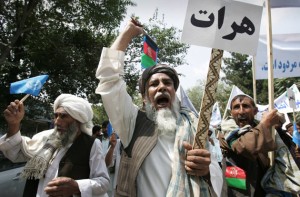Civilian casualties in Afghan conflict decrease in 2012
Tuesday, February 19th, 2013 3:33:01 by Tahir Khan
Civilian casualties in Afghanistan’s armed conflict decreased for the first time in six years, the United Nations Assistance Mission in Afghanistan (UNAMA) said today in releasing its 2012 Annual Report on Protection of Civilians in Armed Conflict prepared in coordination with the United Nations Office of the High Commissioner for Human Rights.
UNAMA documented a 12 per cent drop in civilian deaths and a marginal increase in civilian injuries compared with 2011. UNAMA recorded 7,559 civilian casualties – 2,754 civilian deaths and 4,805 civilian injuries – in 2012. Over the past six years, 14,728 Afghan civilians have lost their lives in the conflict.
The report attributed the reduction in civilian casualties in 2012 to fewer deaths and injuries of civilians from ground engagement among parties to the conflict, a decline in suicide attacks by Anti-Government Elements, reduced numbers of aerial operations, and other measures taken by Pro-Government Forces to minimize harm to civilians.
At the same time, however, UNAMA observed increasing threats to civilians in 2012 associated with the presence and re-emergence of armed groups, particularly in the north and northeast regions of Afghanistan. Civilians also faced an increase in threats, intimidation and interference with their rights to education, health, justice and freedom of movement from Anti-Government Elements.
“The decrease in civilian casualties UNAMA documented in 2012 is very much welcome.” said Jan Kubis, United Nations Special Representative for the Secretary-General in Afghanistan. “Yet, the human cost of the conflict remains unacceptable. Indiscriminate and unlawful use of improvised explosive devices by Anti-Government Elements remains the single biggest killer of civilians. Steep increases in the deliberate targeting of civilians perceived to be supporting the Government demonstrates another grave violation of international humanitarian law. Particularly appalling is the use of suicide attacks including those carried out by brainwashed children to murder civilians which is also a clear breach of the norms of Islam.”
While the overall incidence of civilian casualties decreased in 2012, Anti-Government Elements increasingly targeted civilians throughout the country and carried out attacks without regard for human life. In total, 81 per cent of civilian casualties in 2012 were attributed to Anti-Government Elements.
Eight per cent of civilian casualties resulted from the operations of Pro-Government Forces. Eleven per cent of total civilian casualties could not be attributed to any party to the conflict.
The report found that women and girls continued to suffer enormously from the effects of armed conflict. UNAMA documented 864 female casualties (301 deaths and 563 injuries) in 2012.
“The number of Afghan women and girls killed and injured in the conflict increased by 20 per cent in 2012.” said Georgette Gagnon, Director of Human Rights for UNAMA. “It is the tragic reality that most Afghan women and girls were killed or injured while engaging in their everyday activities.”
UNAMA documented 6,131 civilian casualties (2,179 civilian deaths and 3,952 injuries) caused by Anti-Government Elements, an increase of nine per cent over 2011. UNAMA’s report notes that improvised explosive devices (IEDs) used by Anti-Government Elements were the greatest threat to civilians in 2012, causing 2,531 civilian casualties with 868 civilians killed and 1,663 injured in 782 separate incidents.
Short URL: https://www.newspakistan.pk/?p=38382

















